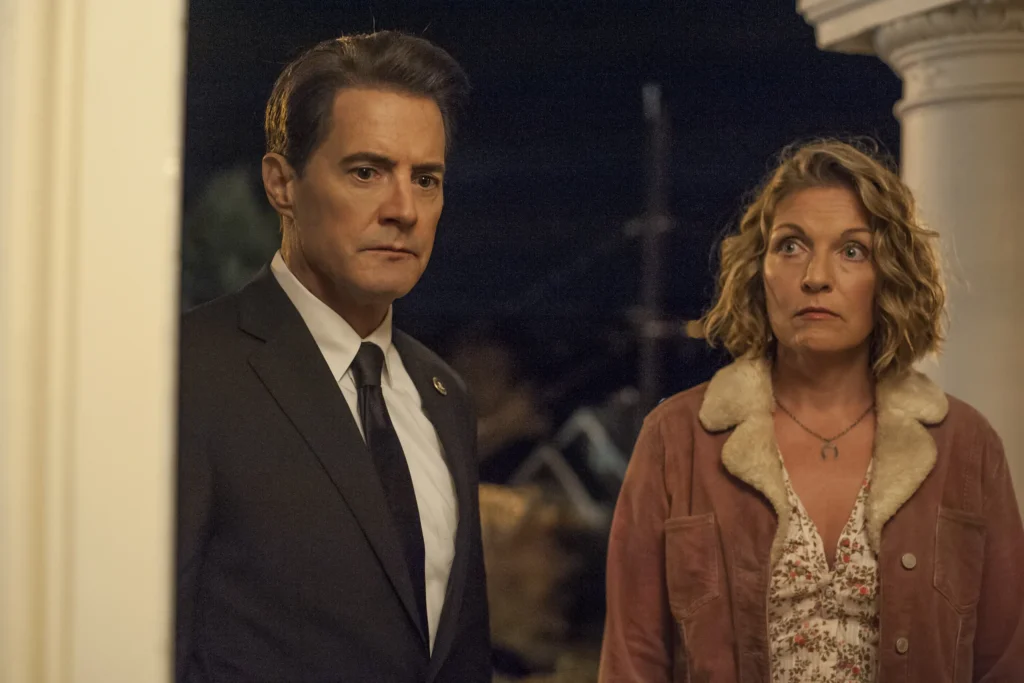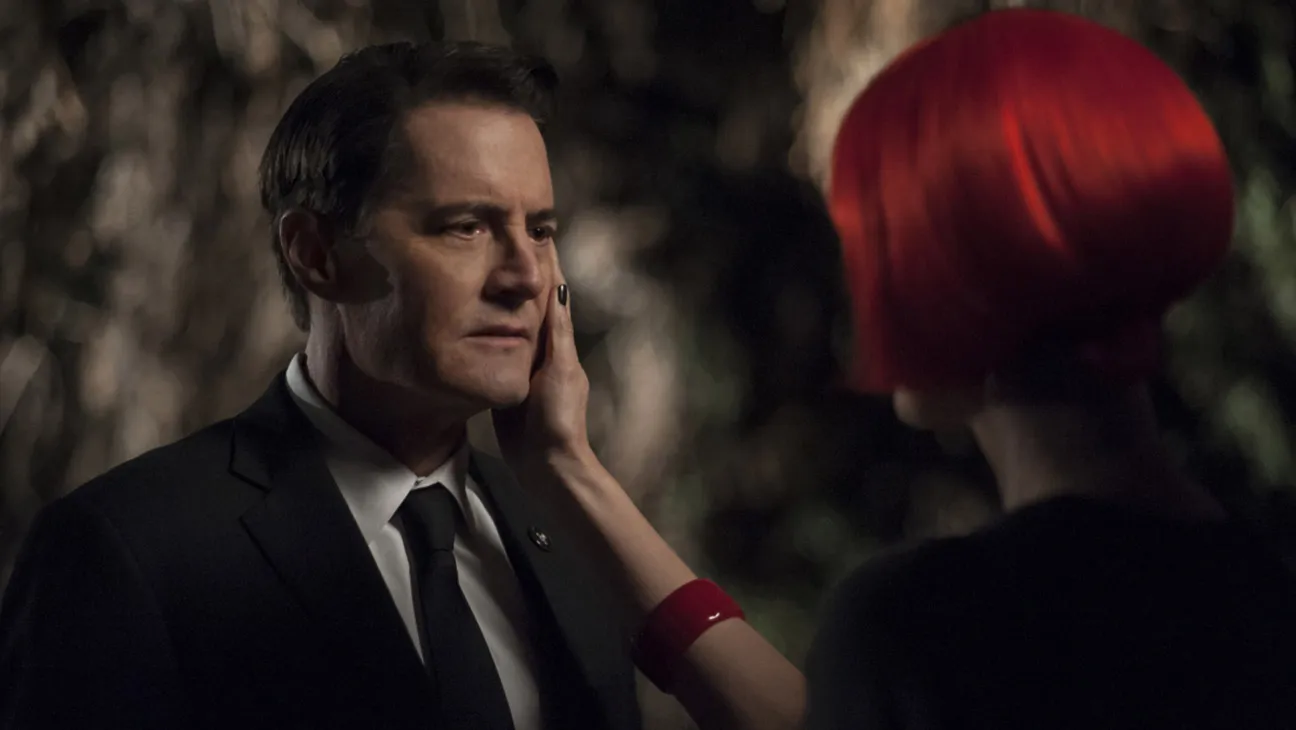In 1990, Twin Peaks revolutionized television by introducing a surreal, cinematic style and long-form, character-driven storytelling. Over 25 years later, in 2017, Twin Peaks: The Return arrived, continuing and reimagining the world David Lynch and Mark Frost created. While the original show set a new standard for what TV could be, The Return pushed the boundaries even further, showing how much the landscape of television and cinema had evolved, and how those changes influenced Lynch’s latest work. However, The Return was not merely a sequel—it was a fundamentally different show, shaped both by Lynch’s unique artistic vision and the changing nature of modern television.
The Original Twin Peaks Revolution
When Twin Peaks debuted in the early 1990s, it stood out for its bold narrative structure, blending crime drama, soap opera, and surrealism. The show’s lasting influence on TV cannot be overstated. It opened the door for what is now called “prestige television,” where complex narratives, high production values, and serialized storytelling became the norm. Without Twin Peaks, many of today’s groundbreaking series, from The Sopranos to Breaking Bad, might not have existed in their current forms.
But while the original show left an indelible mark on television, it was also a product of its time. The quirky blend of humor, mystery, and supernatural intrigue was something that fit the era’s taste, even as it stood apart from other TV shows. However, by the time Twin Peaks: The Return came around, television had changed drastically, and so had the way audiences consumed media.
How Twin Peaks: The Return (2017) Is a Different Show

Twin Peaks: The Return is often described as a completely different show from its predecessor, even though it continues the story from where the original left off. While the original Twin Peaks was grounded (mostly) in the small-town charm of Twin Peaks and its quirky residents, The Return expanded its scope, taking viewers across various locations, from Las Vegas to the strange world of the Black Lodge.
One major difference is in pacing. The original Twin Peaks featured tight, episode-by-episode developments within a larger ongoing mystery, balancing intrigue with moments of humor and emotional connection. The Return, however, adopted a far more abstract and often cryptic approach. The pacing was slower, with long, meditative sequences that demanded patience and careful observation from the audience. Lynch didn’t shy away from episodes that felt more like experimental films than traditional TV episodes. For example, Episode 8 of The Return—widely considered a masterpiece—was a non-linear journey through time and space, featuring strange black-and-white imagery and abstract storytelling that bewildered even the most devoted Twin Peaks fans.
The Return felt less like a continuation of the soap opera-meets-mystery format of the original and more like an extension of Lynch’s cinematic work, such as Mulholland Drive and Inland Empire. It embraced the weird, the unexplained, and the surreal in ways that even the original show didn’t fully explore. Lynch took the opportunity to dive deeper into his experimental roots, making The Return more about atmosphere, dream logic, and challenging the conventions of what TV could be.
How Modern Television Influenced Twin Peaks: The Return

Although The Return was a very different show, it was also influenced by the ways television had changed since the 1990s. By 2017, shows like Breaking Bad, Mad Men, and Game of Thrones had shown that audiences were ready for intricate, slow-burn storytelling, where complex plots and character arcs unfold over time. Modern TV had become more cinematic, with high production values and a focus on directorial vision. This shift allowed Lynch and Frost to create a show that didn’t need to fit into the conventional structures of network TV. Instead, The Return embraced long-form storytelling that wasn’t afraid to challenge viewers.
Another key difference is the role of streaming platforms and binge-watching. In 1990, Twin Peaks aired weekly, giving audiences time to digest each episode, discuss it, and theorize. By 2017, audiences had become accustomed to the binge-watch culture, where entire seasons could be watched in a few sittings. While The Return still aired weekly on Showtime, the new way people consumed TV influenced its structure. With its dense and often ambiguous storytelling, The Return practically demanded multiple viewings, with fans revisiting episodes and scenes to uncover hidden meanings and themes. Streaming services allowed for this kind of re-watching, ensuring that audiences could dig deeper into the mysteries of the show at their own pace.
In addition, modern TV had become more open to the kind of ambiguity that Twin Peaks: The Return thrived on. Shows like “The Leftovers” and “Westworld” were already toying with unresolved questions, abstract storytelling, and complex symbolism, creating a space where Lynch’s vision could be more fully embraced without needing to pander to mainstream tastes.
Cinema’s Influence on The Return
As much as The Return was shaped by modern television, it also owed a lot to the evolution of cinema. Lynch had spent much of the time between Twin Peaks and The Return focused on his film career, directing highly experimental movies like Lost Highway and Inland Empire. These films featured the same kind of surrealism and open-ended narratives that would become central to The Return.
The influence of cinema on The Return is evident in its cinematic scope and style. Lynch shot many scenes with the same care and precision as his films, paying close attention to lighting, composition, and atmosphere. This gave the show a more cinematic feel than its predecessor, with long, uninterrupted takes and sequences that were visually stunning yet emotionally and thematically challenging.
Another cinematic influence on The Return was its use of music. While the original Twin Peaks was known for Angelo Badalamenti’s haunting, melodramatic score, The Return expanded its musical palette to include performances by contemporary bands. Many episodes ended with musical performances at the Roadhouse, a technique that felt more akin to cinema than traditional TV, creating moments of reflection after intense scenes or bewildering plot twists.
The Legacy of Twin Peaks: The Return
Ultimately, Twin Peaks: The Return was a culmination of the changes in both television and cinema over the years. It blended Lynch’s cinematic sensibilities with modern television’s willingness to embrace complexity and ambiguity. While the original Twin Peaks changed the course of TV in the 1990s, The Return challenged the boundaries of what TV could be in the 21st century, pushing viewers to accept long, strange, and often unresolved stories.
The Return wasn’t just a continuation of the Twin Peaks story—it was a meditation on time, memory, and the nature of television itself. It showed how far TV had come since the original series aired, and how the lessons learned from shows like The Sopranos, Breaking Bad, and Lost had shaped the landscape of modern television. More than anything, it proved that Twin Peaks was still ahead of its time, willing to take risks and challenge audiences in ways few shows could.
With The Return, Lynch and Frost didn’t just bring Twin Peaks back—they reinvented it for a new generation, ensuring its place as one of the most influential TV shows ever made.

Chaitanya Tuteja is someone who enjoys sharing his thoughts on books, movies, and shows. Based in India, he appreciates exploring different stories and offering honest reflections. When not reflecting on his favorite media, Chaitanya enjoys discovering new ideas and embracing life’s simple moments.

